MICROSCOPE-ANTIQUES.COM © 2013-15.
SIMPLE MICROSCOPE OUTFIT
C. 1885-1905
SIGNED on the case: 'ACHROMATISKT FICKMIKROSKOP'
MAKER: Paul Waechter
MODEL: 'Achromatic Universal Pocket Microscope'
ALSO CALLED:
ACHROMATISKT FICKMIKROSKOP
(Swedish), or Universalmikroskop
(German,) or Achromatische Universal-Taschenmikroskop
(German)
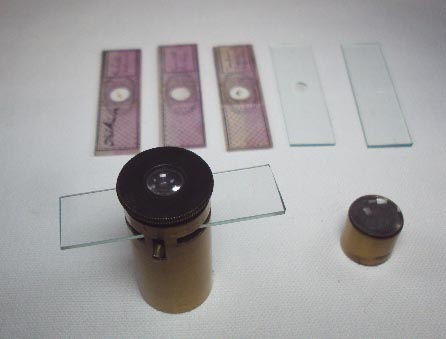
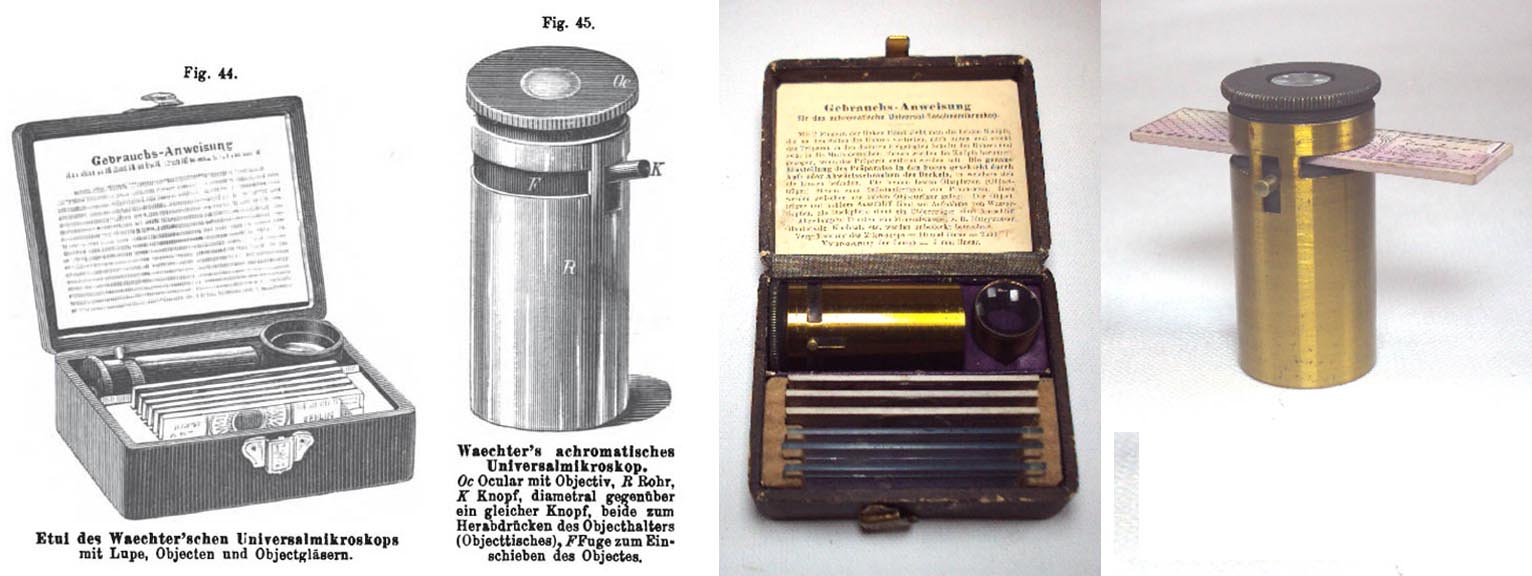 DESCRIPTION: This kit,
made in Germany for the Swedish market, is a simple microscope outfit with a single fixed ocular, separate lupe magnifier,
and included slides; the slides do not have seller or maker names.
Slides are held in place via a slot on the top end
which is spring-loaded. Two small projections on either side allow the slot to open to admit a slide, and
then when released, hold the slide in place.
The outfit also includes six small slides, three prepared and three plain. One of the three empty slides is a
depression slide. These occupy appropriate sized slots
in the front of the case. The case is made of wood or board and is covered in a leather-like material, lined in
purple velour. Instructions in German are printed on the inside of the lid.
The slides are labelled by pen and ink in script. Some have writing on both front and back sides.
They are labelled in German, and difficult to decipher. The outside of the case is embossed in gold letters:
DESCRIPTION: This kit,
made in Germany for the Swedish market, is a simple microscope outfit with a single fixed ocular, separate lupe magnifier,
and included slides; the slides do not have seller or maker names.
Slides are held in place via a slot on the top end
which is spring-loaded. Two small projections on either side allow the slot to open to admit a slide, and
then when released, hold the slide in place.
The outfit also includes six small slides, three prepared and three plain. One of the three empty slides is a
depression slide. These occupy appropriate sized slots
in the front of the case. The case is made of wood or board and is covered in a leather-like material, lined in
purple velour. Instructions in German are printed on the inside of the lid.
The slides are labelled by pen and ink in script. Some have writing on both front and back sides.
They are labelled in German, and difficult to decipher. The outside of the case is embossed in gold letters: ACHROMATISKT FICKMICROSCOPE
which is Swedish for POCKET MICROSCOPE.
Instructions (in German) are glued to the inside of the top of the box. The instructions refer to
it as a Achromatic Universal Pocket Microscope.
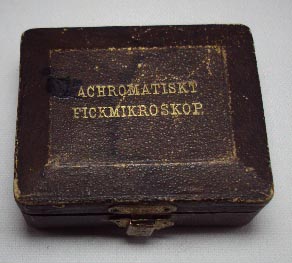
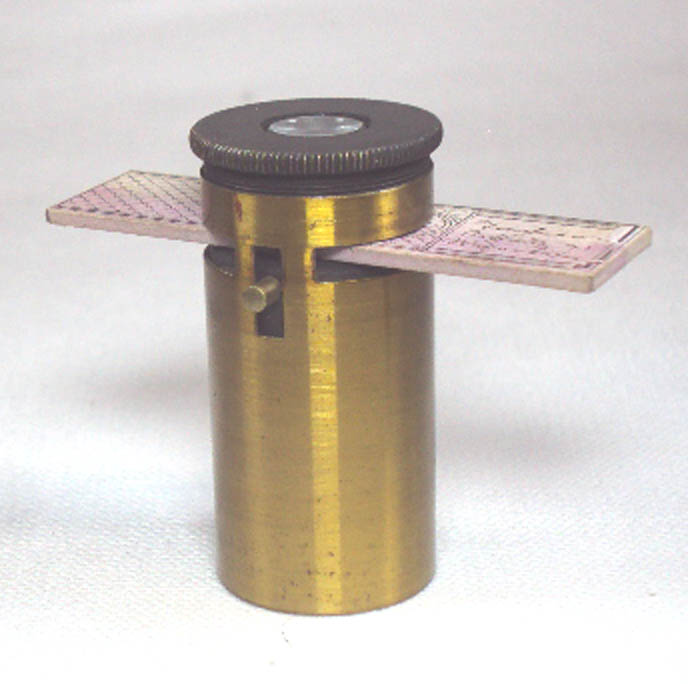
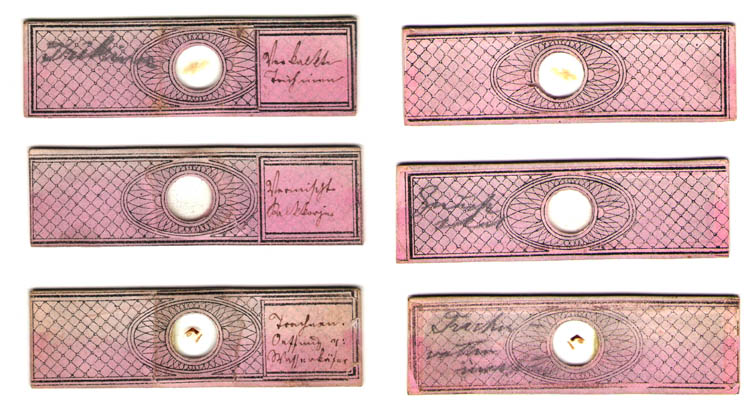
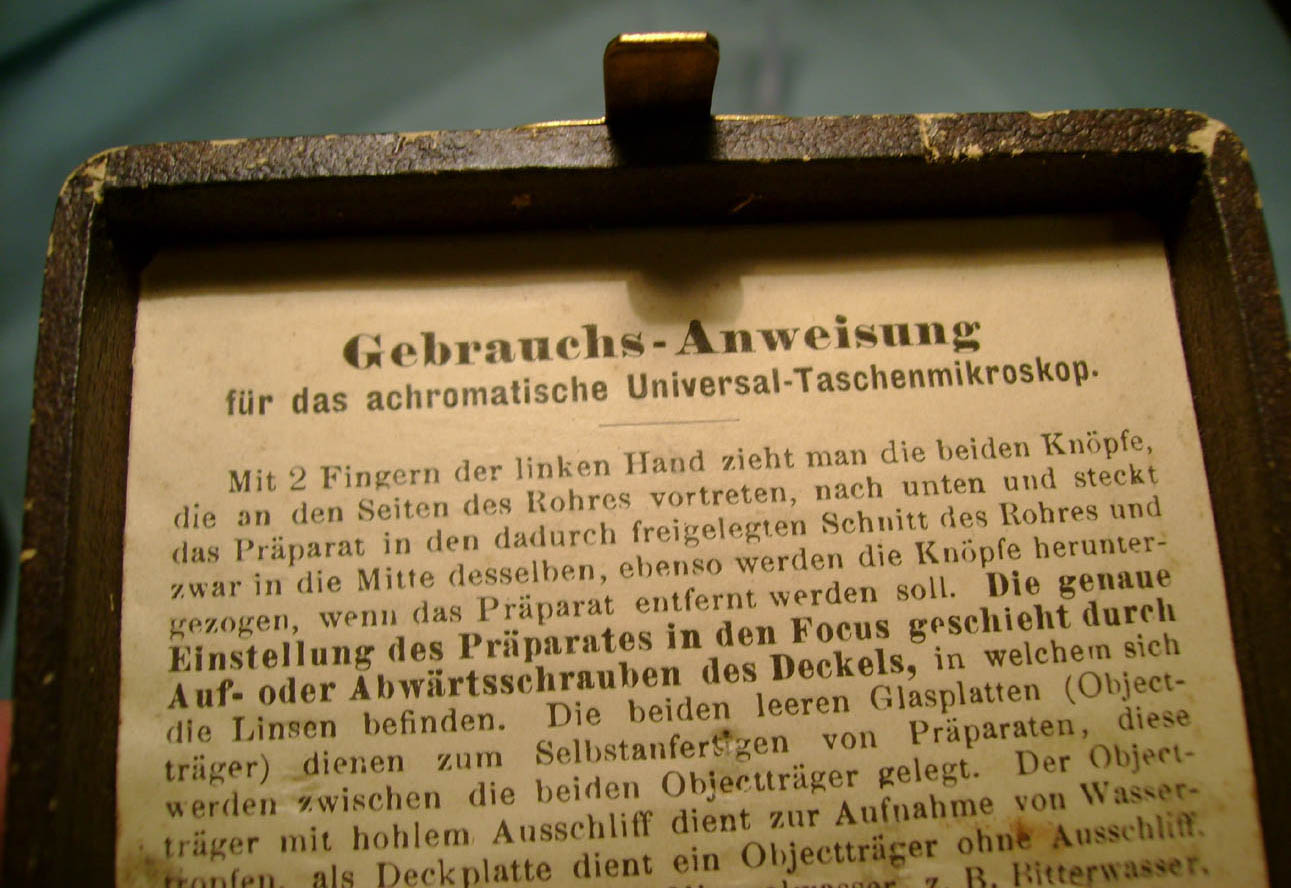
HISTORY: 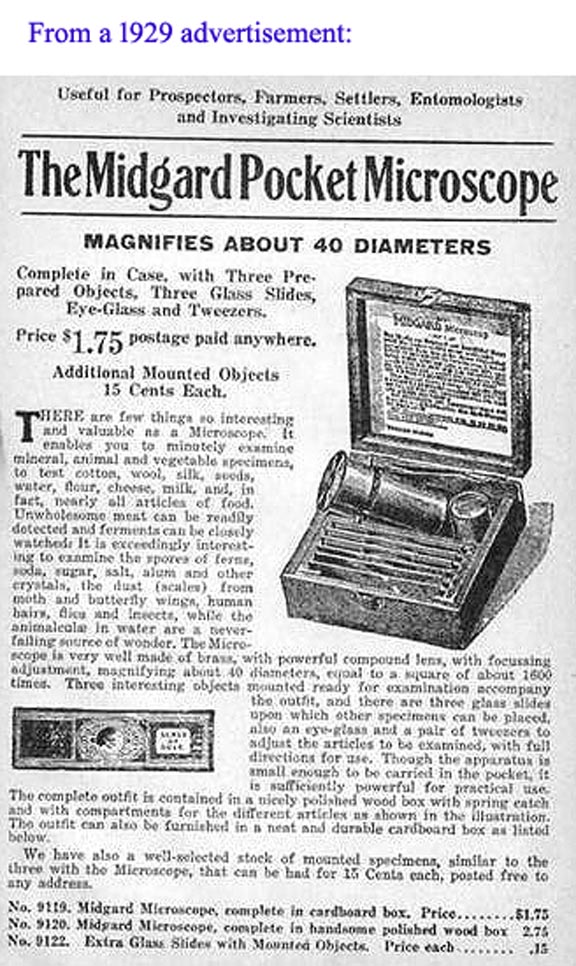 I was able to date this microscope through an entry in a 1903 catalog and another in a German magazine article
from 1886. The labelling on the outside ('Achromatiskt Fickmikroskop') is in Swedish, not German, indicating it was intended for sale in Sweden.
Although microscopes of this general form were very common, the Waechter Achromatic version, shown here, is less common and of much higher quality than many.
They have been referred to as 'Taschenmicroscopes,' 'Algensuscher' or simply Pocket microscopes. About the same time this microscope was first made, the French 'Universal Microscope or Floroscope' (UMF) and its variations were also being sold. The UMF is a much flimsier and lower quality instrument, that, instead of using achromatic optics, uses a Stanhope lens for the high power. Many different German firms sold similar
but not identical instruments. For a similar, but higher quality (and less common) version, see my Leidig Microscope Kit . An outfit similar to this was sold into the second quarter of the 20th century; called the 'Midgard' an ad for this instrument, shown to the right, dates from 1929. The quality of the Midgard lens is not as high as the older Waechter version.
I was able to date this microscope through an entry in a 1903 catalog and another in a German magazine article
from 1886. The labelling on the outside ('Achromatiskt Fickmikroskop') is in Swedish, not German, indicating it was intended for sale in Sweden.
Although microscopes of this general form were very common, the Waechter Achromatic version, shown here, is less common and of much higher quality than many.
They have been referred to as 'Taschenmicroscopes,' 'Algensuscher' or simply Pocket microscopes. About the same time this microscope was first made, the French 'Universal Microscope or Floroscope' (UMF) and its variations were also being sold. The UMF is a much flimsier and lower quality instrument, that, instead of using achromatic optics, uses a Stanhope lens for the high power. Many different German firms sold similar
but not identical instruments. For a similar, but higher quality (and less common) version, see my Leidig Microscope Kit . An outfit similar to this was sold into the second quarter of the 20th century; called the 'Midgard' an ad for this instrument, shown to the right, dates from 1929. The quality of the Midgard lens is not as high as the older Waechter version.

 DESCRIPTION: This kit,
made in Germany for the Swedish market, is a simple microscope outfit with a single fixed ocular, separate lupe magnifier,
and included slides; the slides do not have seller or maker names.
Slides are held in place via a slot on the top end
which is spring-loaded. Two small projections on either side allow the slot to open to admit a slide, and
then when released, hold the slide in place.
The outfit also includes six small slides, three prepared and three plain. One of the three empty slides is a
depression slide. These occupy appropriate sized slots
in the front of the case. The case is made of wood or board and is covered in a leather-like material, lined in
purple velour. Instructions in German are printed on the inside of the lid.
The slides are labelled by pen and ink in script. Some have writing on both front and back sides.
They are labelled in German, and difficult to decipher. The outside of the case is embossed in gold letters:
DESCRIPTION: This kit,
made in Germany for the Swedish market, is a simple microscope outfit with a single fixed ocular, separate lupe magnifier,
and included slides; the slides do not have seller or maker names.
Slides are held in place via a slot on the top end
which is spring-loaded. Two small projections on either side allow the slot to open to admit a slide, and
then when released, hold the slide in place.
The outfit also includes six small slides, three prepared and three plain. One of the three empty slides is a
depression slide. These occupy appropriate sized slots
in the front of the case. The case is made of wood or board and is covered in a leather-like material, lined in
purple velour. Instructions in German are printed on the inside of the lid.
The slides are labelled by pen and ink in script. Some have writing on both front and back sides.
They are labelled in German, and difficult to decipher. The outside of the case is embossed in gold letters: 



 I was able to date this microscope through an entry in a 1903 catalog and another in a German magazine article
from 1886. The labelling on the outside ('Achromatiskt Fickmikroskop') is in Swedish, not German, indicating it was intended for sale in Sweden.
Although microscopes of this general form were very common, the Waechter Achromatic version, shown here, is less common and of much higher quality than many.
They have been referred to as 'Taschenmicroscopes,' 'Algensuscher' or simply Pocket microscopes. About the same time this microscope was first made, the French 'Universal Microscope or Floroscope' (UMF) and its variations were also being sold. The UMF is a much flimsier and lower quality instrument, that, instead of using achromatic optics, uses a Stanhope lens for the high power. Many different German firms sold similar
but not identical instruments. For a similar, but higher quality (and less common) version, see my Leidig Microscope Kit . An outfit similar to this was sold into the second quarter of the 20th century; called the 'Midgard' an ad for this instrument, shown to the right, dates from 1929. The quality of the Midgard lens is not as high as the older Waechter version.
I was able to date this microscope through an entry in a 1903 catalog and another in a German magazine article
from 1886. The labelling on the outside ('Achromatiskt Fickmikroskop') is in Swedish, not German, indicating it was intended for sale in Sweden.
Although microscopes of this general form were very common, the Waechter Achromatic version, shown here, is less common and of much higher quality than many.
They have been referred to as 'Taschenmicroscopes,' 'Algensuscher' or simply Pocket microscopes. About the same time this microscope was first made, the French 'Universal Microscope or Floroscope' (UMF) and its variations were also being sold. The UMF is a much flimsier and lower quality instrument, that, instead of using achromatic optics, uses a Stanhope lens for the high power. Many different German firms sold similar
but not identical instruments. For a similar, but higher quality (and less common) version, see my Leidig Microscope Kit . An outfit similar to this was sold into the second quarter of the 20th century; called the 'Midgard' an ad for this instrument, shown to the right, dates from 1929. The quality of the Midgard lens is not as high as the older Waechter version.